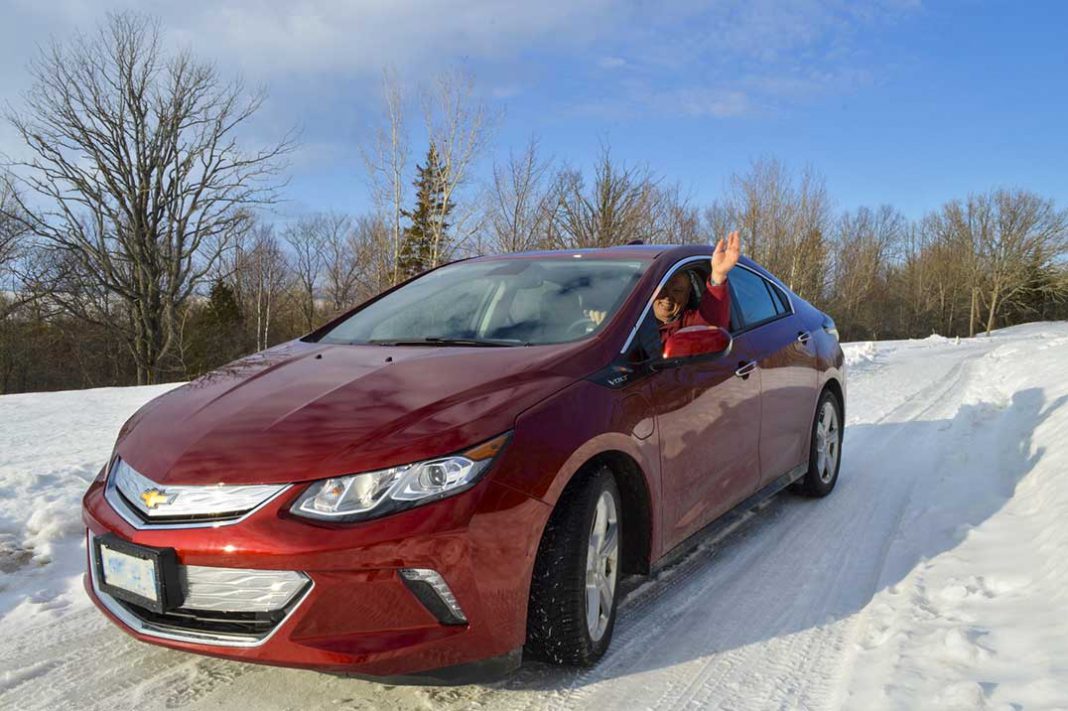By Jan McQuay
MANITOULIN—The first electric vehicles have arrived on Manitoulin Island. Last summer, Ted Kilpatrick of Kagawong became the proud owner of a plug-in hybrid, and Brad Wright of Gore Bay took the leap to an all-electric car.
Mr. Kilpatrick chose a second-generation Chevrolet Volt Plug-in Hybrid, which can travel 85 kilometres on a single battery charge. “I can plug it into my regular home outlet or any conventional charging station. I just program it to charge at night in off-peak electricity hours, and by morning when I want to use it, it’s all charged up” he said.
Since buying the hybrid seven months ago, Mr. Kilpatrick and his wife have driven 14,000 kilometres. They don’t have to worry about stopping on a long trip and waiting for the battery to charge at a charging station, because the gasoline back-up is always available.
“On long trips I don’t stop at charging stations, in fact I’ve never used one” said Mr. Kilpatrick. “The computer automatically switches from the battery to gas, and the tank gives me a range of more than 500 kilometers on top of the 85 kilometres from the battery. “Generally, in winter when the temperature is below freezing, it uses gas. I’ve averaged 3.5 litres per hundred kilometres, which is half what my previous car used. Adding up the cost of electricity and gas, I figure I’ll save about $885 in fuel costs every year.”
By charging the battery overnight when electricity rates are low, a full charge only costs about $1.20. At today’s gas prices, a comparable compact car like the Honda Civic would use about $7 worth of gas to go the same distance, 85 kilometres. “It feels good to drive past gas stations,” said Mr. Kilpatrick.
The Volt also emits half as much carbon dioxide. An internal combustion engine releases 2.3 kilograms of carbon dioxide for every litre of gas, so a car like a Honda Civic that needs seven litres of gas to travel 100 kilometres will release 16 kilograms of carbon dioxide out the tailpipe, much more than the weight of the gasoline. We don’t smell it or see it, but it gets in the air and contributes to global warming.
Brad Wright of Gore Bay never stops at gas stations anymore with his Tesla Model 3. He bought it nine months ago, and already has driven it 33,000 kilometres, frequently travelling to Sudbury and Timmins for work, with no emissions at all. The Tesla doesn’t even have a tailpipe. “The battery has a 520 kilometre range, but actually I can drive 660 kilometres on one charge in the summer,” he said. He charges the battery up at the Tesla Supercharger on Long Lake Road in Sudbury, conveniently close to shopping and restaurants. In half an hour the battery can charge enough to drive 270 kilometres. To date there are no public charging stations on Manitoulin, the nearest is at Northern Ford in Espanola.
Although the Tesla Model 3 has a high price tag and all the bells and whistles of a luxury car including an autopilot feature, operating it is cheaper than cars with internal combustion engines. “It may be more up front to purchase the car,” Mr. Wright explained, “but with no gas, oil changes, brakes lasting longer (regenerative braking), and a simplified drivetrain, the cost to own is drastically less. I spend $2.75 to $3.25 to drive 100 kilometres and it generally costs me $4.86 to drive to Sudbury in my car. That is with our ‘expensive’ electricity rates in Ontario.”
Mr. Wright said he has always dreamed of having a Tesla. He likes the environmental benefits as well as the ongoing savings of using electricity instead of gas. The environmental benefits come thanks to the previous Ontario government, which made history in 2014 as the first jurisdiction in North America to close all of its coal-fired electricity plants. As a result, greenhouse gas emissions from electricity generation fell by about 85 percent from its high five years before when all the coal plants were running.
In Canada, there are now about 100,000 electric vehicles, mostly in Ontario and Quebec. In the federal budget delivered March 19, the Trudeau government announced a $5,000 rebate on new all-electric car purchases, to encourage people to switch from gasoline. Since passenger cars make up more than a fifth of all greenhouse gases from the transportation sector, switching to electric cars can have a significant impact on greenhouse gas emissions in Ontario.
The Intergovernmental Panel on Climate Change said last November in their Special Report that it is vital to maintain the global temperature increase below 1.5°C versus higher levels. “Adaptation will be less difficult. Our world will suffer fewer negative impacts of intensity and frequency of extreme events, on resources, ecosystems, biodiversity, food security, cities, tourism and carbon removal.” In Ontario, electric cars are part of the solution.



